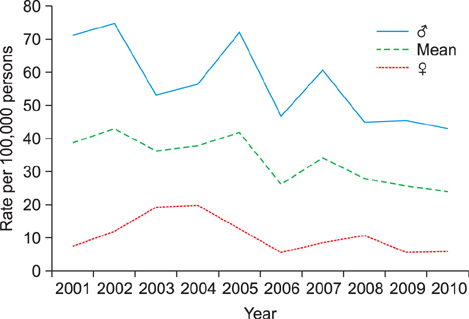Clin Orthop Surg.
2014 Jun;6(2):196-202. 10.4055/cios.2014.6.2.196.
The Incidence of Acute Traumatic Tendon Injuries in the Hand and Wrist: A 10-Year Population-based Study
- Affiliations
-
- 1Division of Plastic Surgery, Mayo Clinic, Rochester, MN, USA. moran.steven@mayo.edu
- 2Department of Orthopedic Surgery, Mayo Clinic, Rochester, MN, USA.
- KMID: 1784667
- DOI: http://doi.org/10.4055/cios.2014.6.2.196
Abstract
- BACKGROUND
Acute traumatic tendon injuries of the hand and wrist are commonly encountered in the emergency department. Despite the frequency, few studies have examined the true incidence of acute traumatic tendon injuries in the hand and wrist or compared the incidences of both extensor and flexor tendon injuries.
METHODS
We performed a retrospective population-based cohort study of all acute traumatic tendon injuries of the hand and wrist in a mixed urban and rural Midwest county in the United States between 2001-2010. A regional epidemiologic database and medical codes were used to identify index cases. Epidemiologic information including occupation, year of injury, mechanism of injury and the injured tendon and zone were recorded.
RESULTS
During the 10-year study period there was an incidence rate of 33.2 injuries per 100,000 person-years. There was a decreasing rate of injury during the study period. Highest incidence of injury occurred at 20-29 years of age. There was significant association between injury rate and age, and males had a higher incidence than females. The majority of cases involved a single tendon, with extensor tendon injuries occurring more frequently than flexor tendons. Typically, extensor tendon injuries involved zone three of the index finger, while flexor tendons involved zone two of the index finger. Work-related injuries accounted for 24.9% of acute traumatic tendon injuries. The occupations of work-related injuries were assigned to major groups defined by the 2010 Standard Occupational Classification structure. After assigning these patients' occupations to respective major groups, the most common groups work-related injuries occurred in construction and extraction occupations (44.2%), food preparation and serving related occupations (14.4%), and transportation and material moving occupations (12.5%).
CONCLUSIONS
Epidemiology data enhances our knowledge of injury patterns and may play a role in the prevention and treatment of future injuries, with an end result of reducing lost work time and economic burden.
MeSH Terms
Figure
Reference
-
1. Clark DP, Scott RN, Anderson IW. Hand problems in an accident and emergency department. J Hand Surg Br. 1985; 10(3):297–299.2. Tuncali D, Yavuz N, Terzioglu A, Aslan G. The rate of upper-extremity deep-structure injuries through small penetrating lacerations. Ann Plast Surg. 2005; 55(2):146–148.3. Broback LG, Ekdahl PH, Aschan GW, Grenabo JK. Clinical and socio-economical aspects of hand injuries. Acta Chir Scand. 1978; 144(7-8):455–461.4. Hoxie SC, Capo JA, Dennison DG, Shin AY. The economic impact of electric saw injuries to the hand. J Hand Surg Am. 2009; 34(5):886–889.5. Mathur N, Sharma KK. Medico-economic implications of industrial hand injuries in India. J Hand Surg Br. 1988; 13(3):325–327.6. O'Sullivan ME, Colville J. The economic impact of hand injuries. J Hand Surg Br. 1993; 18(3):395–398.7. Rosberg HE, Carlsson KS, Hojgard S, Lindgren B, Lundborg G, Dahlin LB. What determines the costs of repair and rehabilitation of flexor tendon injuries in zone II? A multiple regression analysis of data from southern Sweden. J Hand Surg Br. 2003; 28(2):106–112.8. Melton LJ 3rd. History of the Rochester Epidemiology Project. Mayo Clin Proc. 1996; 71(3):266–274.9. US Department of Labor. Standard occupational classification [Internet]. Washington, DC: US Department of Labor;cited 2013 Mar 30. Available from: http://www.bls.gov/soc/.10. Bergstralh EJ, Offord KP, Chu CP, Beard CM, O'Fallon WM, Melton LJ. Report No.: Technical Report No 49. Calculating incidence, prevalence and mortality rates for Olmsted County, Minnesota: an update. Rochester: Mayo Clinic;1992.11. Sorock GS, Lombardi DA, Courtney TK, Cotnam JP, Mittleman MA. Epidemiology of occupational acute traumatic hand injuries: a literature review. Saf Sci. 2001; 38(3):241–256.12. Hill C, Riaz M, Mozzam A, Brennen MD. A regional audit of hand and wrist injuries: a study of 4873 injuries. J Hand Surg Br. 1998; 23(2):196–200.13. Campbell AS. Hand injuries at leisure. J Hand Surg Br. 1985; 10(3):300–302.14. Koul AR, Patil RK, Philip V. Complex extensor tendon injuries: early active motion following single-stage reconstruction. J Hand Surg Eur Vol. 2008; 33(6):753–759.15. Lee SK, Dubey A, Kim BH, Zingman A, Landa J, Paksima N. A biomechanical study of extensor tendon repair methods: introduction to the running-interlocking horizontal mattress extensor tendon repair technique. J Hand Surg Am. 2010; 35(1):19–23.16. Manske PR. History of flexor tendon repair. Hand Clin. 2005; 21(2):123–127.17. Newmeyer WL 3rd. History of the journal of hand surgery: 1976-1999. J Hand Surg Am. 2000; 25(1):5–13.18. Soni P, Stern CA, Foreman KB, Rockwell WB. Advances in extensor tendon diagnosis and therapy. Plast Reconstr Surg. 2009; 123(2):727–728.19. Van Tassel DC, Owens BD, Wolf JM. Incidence estimates and demographics of scaphoid fracture in the U.S. population. J Hand Surg Am. 2010; 35(8):1242–1245.


